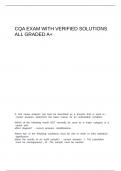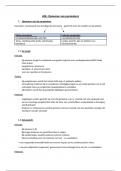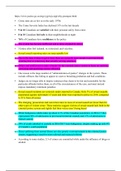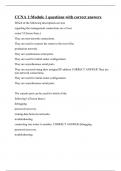Week 1: Introduction to Algorithms and Data Structures
Definition of algorithms and data structures
Algorithms and data structures are two fundamental concepts in computer
science and programming. An algorithm is a step-by-step procedure for solving a
problem or accomplishing a task. It is a set of instructions that a computer can
follow to complete a task, and it can be expressed in a variety of ways, including
natural language, pseudocode, and programming languages.
On the other hand, data structures are the way in which data is organized and
stored in a computer's memory. They are used to represent the relationships
between data elements and provide efficient ways to access, store, and
manipulate data. Common examples of data structures include arrays, linked
lists, stacks, queues, trees, and graphs.
Together, algorithms and data structures form the backbone of computer
programming and are essential for designing efficient and scalable software
systems. They help programmers write code that can handle large amounts of
data, process it quickly, and perform complex tasks with ease.
Importance of DSA in computer science
Data structures and algorithms (DSA) are fundamental concepts in computer
science and are essential for the development of efficient software solutions.
DSA is the backbone of computer science and plays a crucial role in various
areas of computer science, including software engineering, artificial intelligence,
machine learning, data science, and many others.
The importance of DSA in computer science is highlighted by the following factors:
Efficiency: DSA helps in designing algorithms that are efficient and require less time and
memory to execute. In software development, where performance is crucial, the use of
efficient algorithms and data structures can make a significant difference in the overall
performance of the software.
,Problem Solving: DSA provides a systematic approach to problem-solving. By breaking
down a complex problem into smaller sub-problems, and solving them using
appropriate algorithms and data structures, it becomes easier to solve the overall
problem.
Reusability: Algorithms and data structures are reusable components that can be used
in multiple software applications. By using established algorithms and data structures,
developers can save time and effort in designing new solutions and can focus on other
aspects of software development.
Scalability: DSA plays a crucial role in designing scalable software solutions. As the size
of data increases, it becomes essential to use efficient data structures and algorithms
to process the data in a reasonable amount of time.
In summary, DSA is a vital aspect of computer science that provides a systematic
approach to problem-solving, improves the efficiency and scalability of software
solutions, and promotes code reusability. Mastery of DSA is essential for any computer
science student or professional who aims to develop efficient and scalable software
solutions.
Overview of complexity analysis and big O notation
Complexity analysis is an important aspect of algorithm design and analysis. It
involves analyzing the efficiency of algorithms in terms of their time and space
complexity. Time complexity refers to the amount of time an algorithm takes to
execute, while space complexity refers to the amount of memory an algorithm
requires to run.
Big O notation is a mathematical notation used to describe the upper bound of an
algorithm's time or space complexity. It is used to express the worst-case
scenario of an algorithm's performance, in terms of the size of the input. The
notation uses the letter O followed by a function to represent the upper bound of
an algorithm's performance.
, For example, O(1) represents constant time complexity, where the algorithm
takes the same amount of time to execute, regardless of the size of the input.
O(n) represents linear time complexity, where the time taken to execute the
algorithm increases linearly with the size of the input. O(nlogn) represents
logarithmic time complexity, where the time taken to execute the algorithm
increases at a slower rate than linearly, but faster than constant time. O(n^2)
represents quadratic time complexity, where the time taken to execute the
algorithm increases quadratically with the size of the input, and so on.
Big O notation allows us to compare the performance of different algorithms and
to choose the most efficient algorithm for a given problem. It also helps in
optimizing algorithms and improving their performance by identifying and
removing any inefficiencies.
Common algorithm design techniques
There are several common algorithm design techniques that are commonly used to
solve different types of problems. Here are some of them:
Divide and conquer: This technique involves breaking down a problem into smaller
sub-problems that can be solved individually. Once the sub-problems are solved, their
solutions are combined to solve the original problem. Examples of problems that can be
solved using divide and conquer technique include sorting, searching, and matrix
multiplication.
Divide and Conquer: Implementing binary search.
int binarySearch(int arr[], int l, int r, int x) {
if (r >= l) {
int mid = l + (r - l) / 2;
if (arr[mid] == x) {
return mid;
}
if (arr[mid] > x) {
return binarySearch(arr, l, mid - 1, x);
}
return binarySearch(arr, mid + 1, r, x);
}
return -1;
}
, Dynamic programming: This technique involves breaking down a problem into smaller
sub-problems that can be solved independently. The solutions to these sub-problems
are then combined to solve the original problem. Dynamic programming is useful in
solving problems that have overlapping sub-problems, such as the Knapsack problem.
Dynamic Programming: Implementing the Fibonacci sequence.
int fib(int n) {
if (n <= 1) {
return n;
}
int memo[n+1];
memo[0] = 0;
memo[1] = 1;
for (int i = 2; i <= n; i++) {
memo[i] = memo[i-1] + memo[i-2];
}
return memo[n];
}
Greedy algorithms: Greedy algorithms make the locally optimal choice at each step in
the hope of finding a global optimum solution. This technique is useful for solving
optimization problems that have a greedy choice property. Examples of problems that
can be solved using greedy algorithms include the Minimum Spanning Tree problem
and the Huffman coding problem.
Greedy Method: Implementing the coin change problem.
int coinChange(int coins[], int n, int amount) {
int count = 0;
for (int i = n - 1; i >= 0; i--) {
while (amount >= coins[i]) {
amount -= coins[i];
count++;
}
}
return count;
}
Backtracking: Backtracking is a technique that involves recursively trying out different
solutions to a problem until a solution is found. If a solution cannot be found, the
algorithm backtracks and tries another solution. Backtracking is useful for solving
problems that have a large search space, such as the Sudoku puzzle.










